Developer Guide
Table of Contents
- Acknowledgements
- Setting up, getting started
- Design
- Implementation
- Documentation, logging, testing, configuration, dev-ops
- Appendix: Requirements
- Appendix: Instructions for manual testing
- Appendix: Planned Enhancements
- Appendix: Effort
Acknowledgements
This project is based on the AddressBook-Level3 project created by the SE-EDU initiative.
Setting up, getting started
Refer to the guide Setting up and getting started.
Design
.puml files used to create diagrams in this document docs/diagrams folder. Refer to the PlantUML Tutorial at se-edu/guides to learn how to create and edit diagrams.
Architecture

The Architecture Diagram given above explains the high-level design of TAvigator.
Given below is a quick overview of main components and how they interact with each other.
Main components of the architecture
Main (consisting of classes Main and MainApp) is in charge of the app launch and shut down.
- At app launch, it initializes the other components in the correct sequence, and connects them up with each other.
- At shut down, it shuts down the other components and invokes cleanup methods where necessary.
The bulk of the app’s work is done by the following four components:
-
UI: The UI of the App. -
Logic: The command executor. -
Model: Holds the data of the App in memory. -
Storage: Reads data from, and writes data to, the hard disk.
Commons represents a collection of classes used by multiple other components.
How the architecture components interact with each other
The Sequence Diagram below shows how the components interact with each other for the scenario where the user issues the command delete 1.

Each of the four main components (also shown in the diagram above),
- defines its API in an
interfacewith the same name as the Component. - implements its functionality using a concrete
{Component Name}Managerclass (which follows the corresponding APIinterfacementioned in the previous point).
For example, the Logic component defines its API in the Logic.java interface and implements its functionality using the LogicManager.java class which follows the Logic interface. Other components interact with a given component through its interface rather than the concrete class (reason: to prevent outside component’s being coupled to the implementation of a component), as illustrated in the (partial) class diagram below.

The sections below give more details of each component.
UI component
The API of this component is specified in Ui.java

The UI consists of a MainWindow that is made up of parts e.g.CommandBox, ResultDisplay, PersonListPanel, StatusBarFooter etc. All these, including the MainWindow, inherit from the abstract UiPart class which captures the commonalities between classes that represent parts of the visible GUI.
The UI component uses the JavaFx UI framework. The layout of these UI parts are defined in matching .fxml files that are in the src/main/resources/view folder. For example, the layout of the MainWindow is specified in MainWindow.fxml
The UI component,
- executes user commands using the
Logiccomponent. - listens for changes to
Modeldata so that the UI can be updated with the modified data. - keeps a reference to the
Logiccomponent, because theUIrelies on theLogicto execute commands. - depends on some classes in the
Modelcomponent, as it displaysPersonobject residing in theModel.
Logic component
API : Logic.java
Here’s a (partial) class diagram of the Logic component:

The sequence diagram below illustrates the interactions within the Logic component, taking execute("delete 1") API call as an example.

DeleteCommandParser should end at the destroy marker (X) but due to a limitation of PlantUML, the lifeline reaches the end of diagram.
How the Logic component works:
- When
Logicis called upon to execute a command, it is passed to anAddressBookParserobject which in turn creates a parser that matches the command (e.g.,DeleteCommandParser) and uses it to parse the command. - This results in a
Commandobject (more precisely, an object of one of its subclasses e.g.,DeleteCommand) which is executed by theLogicManager. - The command can communicate with the
Modelwhen it is executed (e.g. to delete a person). - The result of the command execution is encapsulated as a
CommandResultobject which is returned back fromLogic.
Here are the other classes in Logic (omitted from the class diagram above) that are used for parsing a user command:

How the parsing works:
- When called upon to parse a user command, the
AddressBookParserclass creates anXYZCommandParser(XYZis a placeholder for the specific command name e.g.,AddCommandParser) which uses the other classes shown above to parse the user command and create aXYZCommandobject (e.g.,AddCommand) which theAddressBookParserreturns back as aCommandobject. - All
XYZCommandParserclasses (e.g.,AddCommandParser,DeleteCommandParser, …) inherit from theParserinterface so that they can be treated similarly where possible e.g, during testing.
Model component
API : Model.java

The Model component,
- stores the address book data i.e., all
Personobjects (which are contained in aUniquePersonListobject). - stores the currently ‘selected’
Personobjects (e.g., results of a search query) as a separate filtered list which is exposed to outsiders as an unmodifiableObservableList<Person>that can be ‘observed’ e.g. the UI can be bound to this list so that the UI automatically updates when the data in the list change. - stores a
UserPrefobject that represents the user’s preferences. This is exposed to the outside as aReadOnlyUserPrefobjects. - does not depend on any of the other three components (as the
Modelrepresents data entities of the domain, they should make sense on their own without depending on other components)
Tag list in the AddressBook, which Person references. This allows AddressBook to only require one Tag object per unique tag, instead of each Person needing their own Tag objects.
Storage component
API : Storage.java

The Storage component,
- can save both address book data and user preference data in JSON format, and read them back into corresponding objects.
- inherits from both
AddressBookStorageandUserPrefStorage, which means it can be treated as either one (if only the functionality of only one is needed). - depends on some classes in the
Modelcomponent (because theStoragecomponent’s job is to save/retrieve objects that belong to theModel)
Common classes
Classes used by multiple components are in the seedu.addressbook.commons package.
Implementation
This section describes some noteworthy details on how certain features are implemented.
List features
Two types of list commands, list students and list attendance, have been implemented.
list students allows users to return to the full list of students who are in the currently selected course.
list attendance allows users to view a summary of the attendance records and the list of absentees for each week for the students in the currently selected course or if specified, the tutorial group.
Implementation
Both list commands are parsed with ListCommandParser. If parsed successfully, it returns either
a ListStudentsCommand or ListAttendanceCommand object.
The following is a class diagram depicting ListCommand, ListStudentsCommand and ListAttendanceCommand:

The following sequence diagram shows how ListStudentsCommand works:
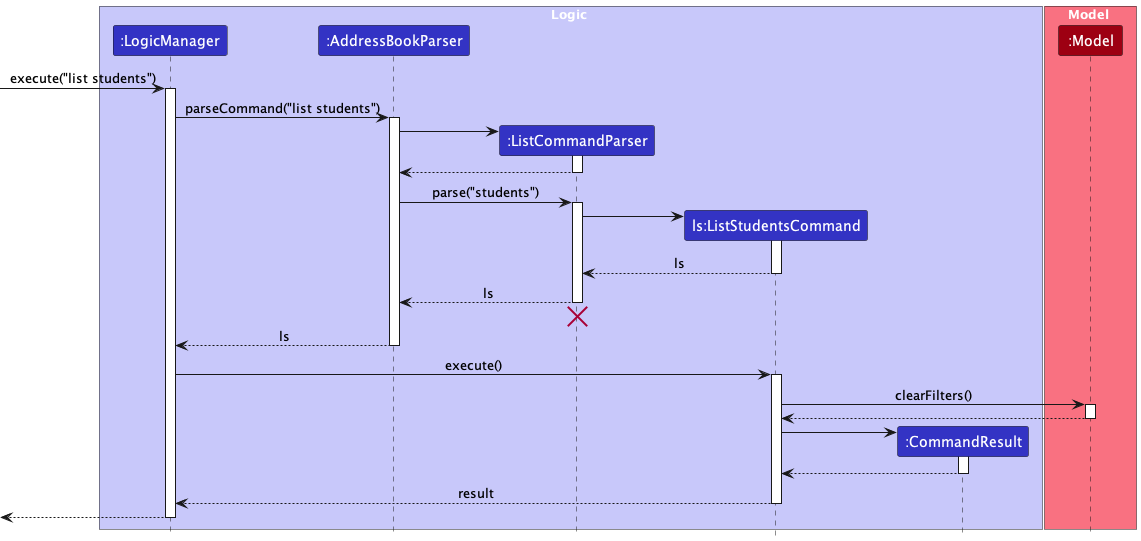
In this example, the user enters list students.
ListCommandParser should end at the destroy marker (X) but due to a limitation of PlantUML, the lifeline reaches the end of diagram.
The following sequence diagram shows how ListAttendanceCommand works:

In this example, the user enters list attendance w/1 tg/G2, where there are valid students in Tutorial Group G2 and all attendances are marked for the students in Tutorial Group G2.
ListCommandParser should end at the destroy marker (X) but due to a limitation of PlantUML, the lifeline reaches the end of diagram.
The following activity diagram summarizes what happens when the user executes a ListAttendanceCommand.
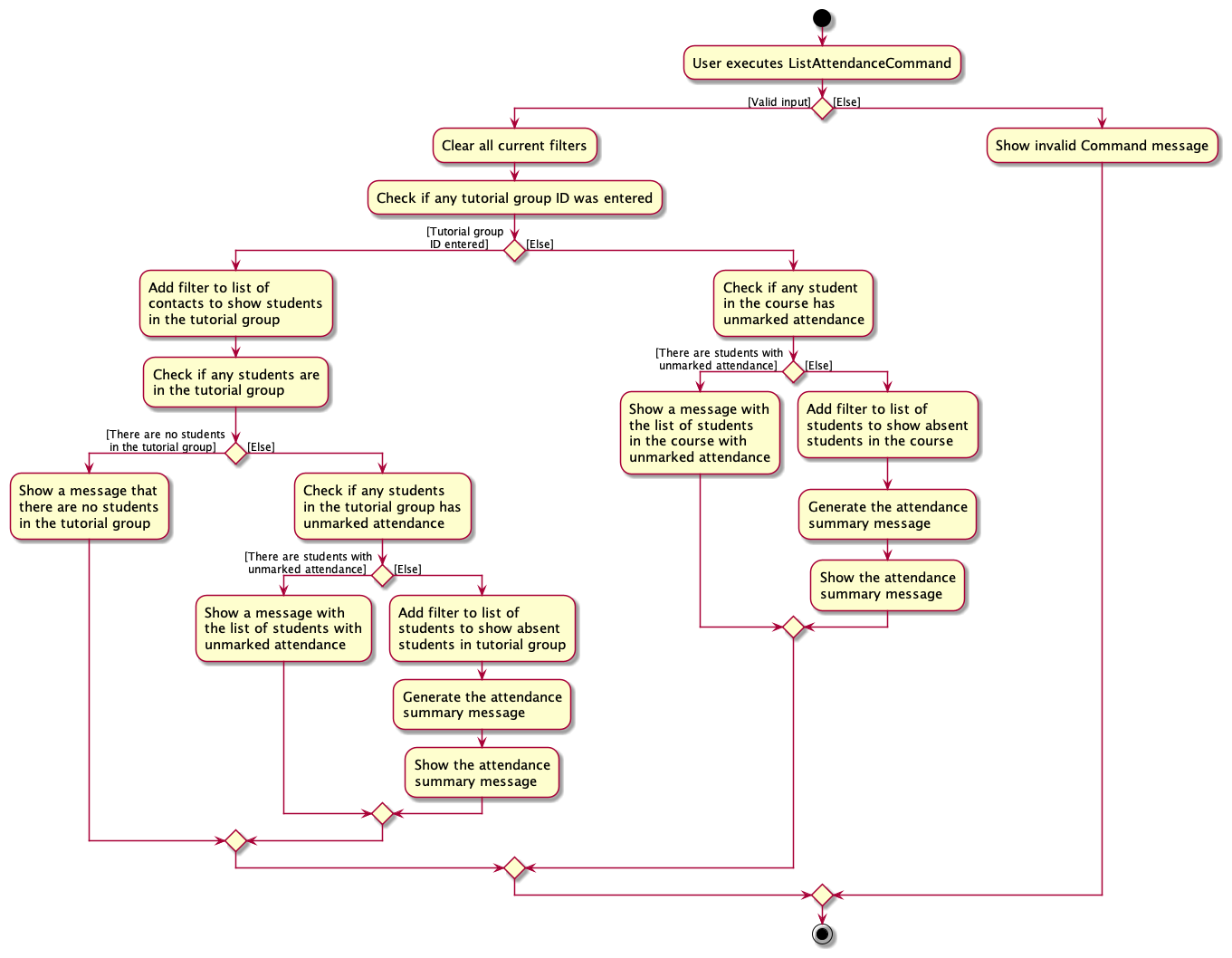 This shows the possible outcomes of
This shows the possible outcomes of ListAttendanceCommand and how to reach each of them.
Design considerations:
The current implementation of ListAttendanceCommand aims to provide a view of the attendance records for the week in a concise manner,
by only showing a statistical summary of the attendances and the list of absentees.
The tutorial group ID is also implemented as an optional field to give users greater flexibility.
Specific messages are also shown when attendances are not fully marked and when there are no students in a specified tutorial group
instead of a generic error message. This was implemented so that users can more easily rectify these mistakes.
Alternative implementations considered but not adopted:
-
Using a different class structure for the
listcommandsInstead of separating
ListAttendanceCommandandListStudentsCommandinto two classes that extend fromListCommand, we could have usedListCommandonly, splitting Attendance and Students into 2 cases.Pros:
- Simplifies class structure.
- Adds functionality to
ListCommand: CurrentlyListCommanddoes not have any functionality and might be redundant.
Cons:
- Reduces OOP and extensibility: Current implementation allows for more
listcommands to be added easily.
Evaluation:
The current implementation is preferred as it has greater OOP and provides more extensibility. Future
listcommands can then be implemented more easily. The current implementation ofListCommandalso has a uniqueMESSAGE_USAGEtext, which reduces its redundancy. -
Different format for information shown by
ListAttendanceCommandInstead of the UI message showing the statistical summary of attendance and the model showing the list of absentees, we could have the UI message show the statistical summary as well as the names of absentees and their reasons of absences and the model show the full list of students.
Pros:
- Allows the user to view the reason of absence immediately, which is currently in neither the UI message nor the model.
Cons:
- Causes UI message to become more cluttered and require more scrolling, which is not ideal, especially since it is supposed to be a summary.
- Does not make full use of the model.
Evaluation:
The current implementation is preferred as it gives the user a clear and concise summary of the week’s attendances, which is in line with the intention and design of the feature. If the user wants to know the reason of absence, they could use the
ViewCommand.
Mark attendance feature
Implementation
The mark attendance feature is implemented using the MarkAttendanceCommand class. It is parsed by the MarkAttendanceCommandParser class.
If parsed successfully, it returns a MarkAttendanceCommand object.
The following sequence diagram shows how the MarkAttendanceCommand works:
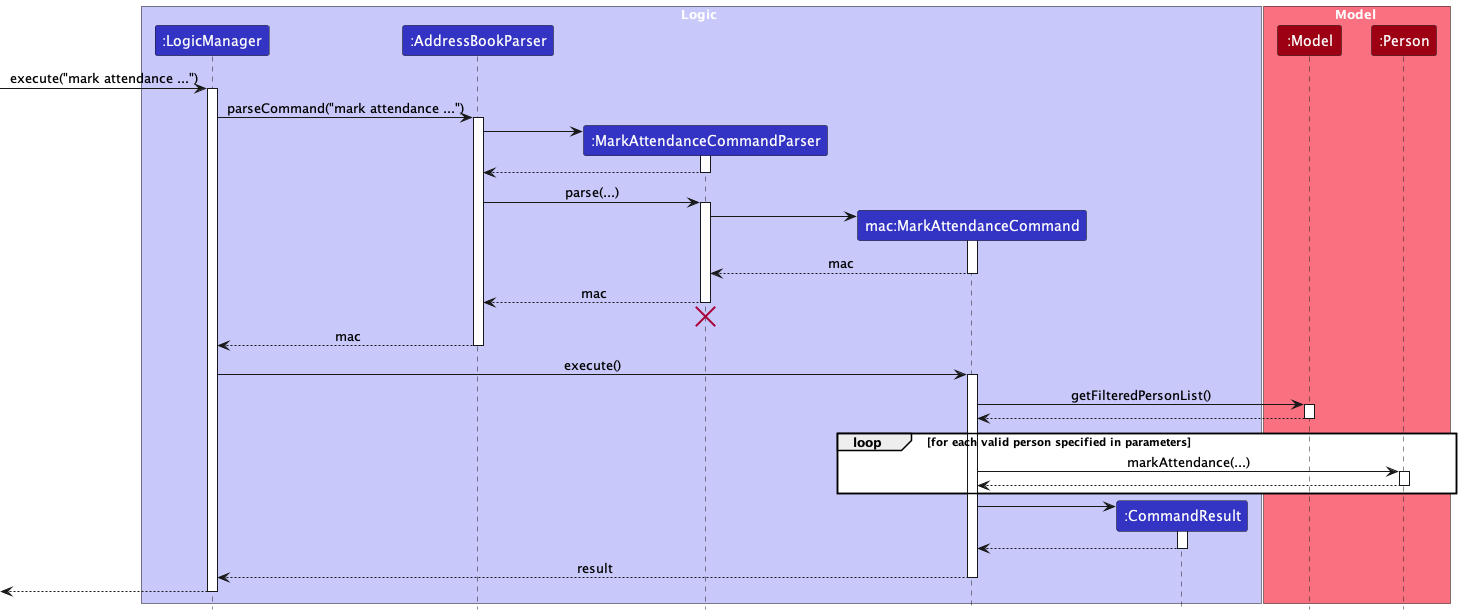
In this example, the user enters mark, followed by a string of arguments.
MarkAttendanceCommandParser should end at the destroy marker (X) but due to a limitation of PlantUML, the lifeline reaches the end of diagram.
The following activity diagram shows how the MarkAttendanceCommand works:
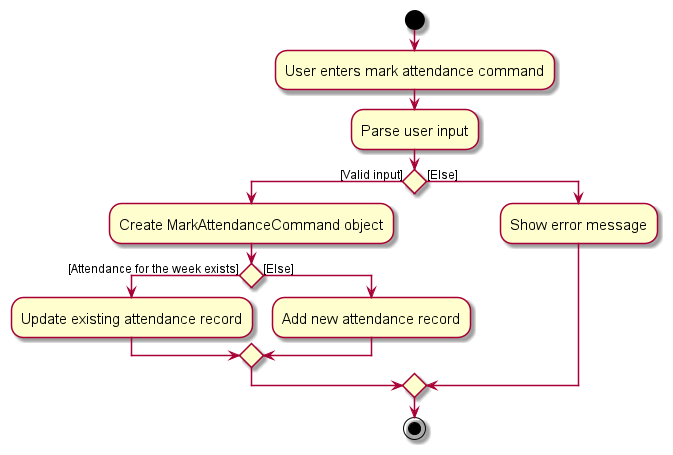
Design considerations:
MarkAttendanceCommand was implemented this way with the idea of providing flexibility to the user. By allowing user to mark attendance using either the student’s name or ID, it caters to different user preferences. The check for existing attendance for the current week ensures that the user does not accidentally create duplicate records for the same week.
Alternative implementations considered but not adopted:
-
Using a separate command for updating attendance
Instead of having the command handle both marking and updating attendance, we could have a separate command, say
UpdateAttendanceCommand, to handle updates.Pros:
- Easier to understand and maintain: Developers can quickly grasp the purpose of each command.
Cons:
- Increased complexity: Introducing more commands can make the system more complex and harder for users to remember.
- Redundancy: Both commands would have overlapping code, leading to potential redundancy.
Evaluation:
The current implementation is preferred as it is simpler and more straightforward. It reduces the need for users to remember additional commands, while resolving potential user mistakes behind the scene, providing convenience and a better user experience. The additional complexity introduced by having a separate command for updating attendance is not justified.
-
Not checking for same week’s attendance
Instead of checking if the attendance for the same week, we could simply add a new attendance record every time the command is invoked.
Pros:
- Simplicity: Implementation would be straightforward without the need for additional checks.
- Flexibility: Allows for multiple attendance records within the same week, which might be useful in some scenarios.
Cons:
- Redundancy: Multiple attendance records for the same week can lead to confusion and redundancy.
- Inefficiency: Consumes more memory and might make querying slower if there are many redundant records.
Evaluation:
The current implementation is preferred as the pros simply do not outweigh the cons. The potential scenario that multiple attendance records within the same week being potentially useful is not justified as it is virtually unlikely to happen. The current implementation is much better preferred as the check prevents potential user mistakes behind the scene, providing convenience and a better user experience.
View Tallied Attendance feature
Implementation
The tallied attendance feature is implemented as a method in the Person class, where attendance records are currently being stored as an arrayList of Attendance objects. The getTalliedAttendance method iterates through the attendance records to return the ratio of tutorials attended to the total number of tutorials.
Design considerations:
This feature is implemented this way, where it is displayed to the user without any additional commands, so that the user can quickly view a summary of the student’s attendance records at a glance.
Alternative implementations considered but not adopted:
Another possible way to implement this feature would be to abstract the attendance records into a separate class.
Pros:
- Extendability: This method will increase the ease of implementing features relating to attendance in the future.
Cons:
- Redundancy: At the current stage, abstracting it into a separate class will greatly increase code complexity without bringing much convenience.
View Detailed Attendance Records feature
Implementation
The view feature allows the user to view the detailed attendance records of the students in the contact list. This
feature is implemented using the ViewCommand class. It is parsed by the ViewCommandParser class. If parsed
successfully, it returns a ViewCommand object.
The following sequence diagram shows how the ViewCommand function works:
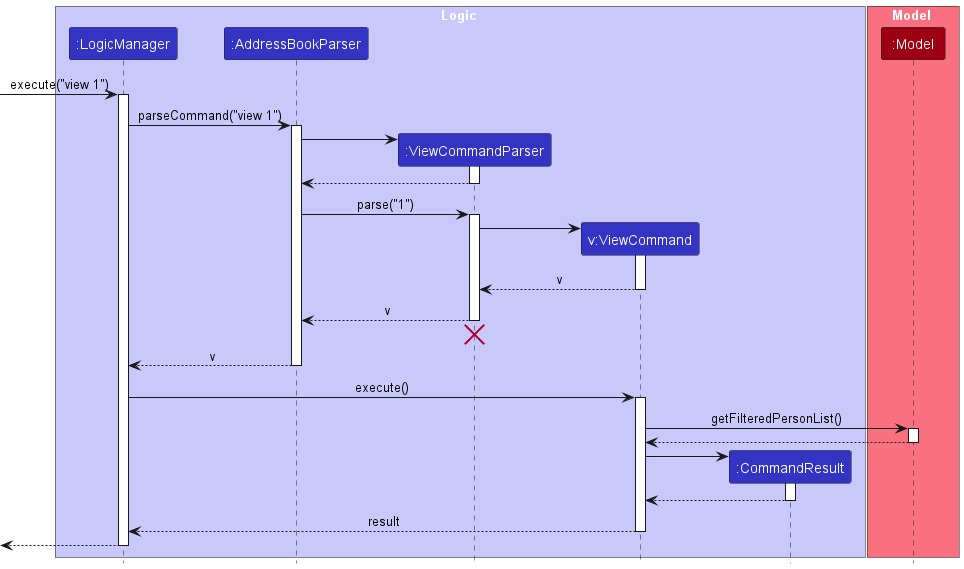
In this example, the user enters view 1.
ViewCommandParser should end at the destroy marker (X) but due to a limitation of PlantUML, the lifeline reaches the end of diagram.
The following activity diagram summarizes what happens when a user executes a ViewCommand:

Design considerations
The feature is implemented this way in order to access each individual’s attendance records in a quick and efficient manner. By using the index of the contact, the user need not type out the individual’s full name, keeping the command short and quick, especially when the user may have to view multiple attendance records in quick succession.
Alternative implementations considered but not adopted:
-
Integrate the attendance records to be part of the UI
Instead of having the user to enter a command to view individual attendance records, we could have the attendance records being shown constantly on the UI for every single contact
Pros:
- Implementation would be quite straightforward and simple without having to add a new command
ViewCommandand its parserViewCommandParser. - Theoretically, users would be able to view every student’s attendance records almost instantly.
Cons:
- The UI could end up being extremely cluttered especially considering that each student might have 13 rows of attendance to show. This could result in information overload and drastically reduce the user-friendliness of the UI.
Evaluation:
The current implementation, despite having to add new classes, is the optimal way to go about implementing this feature as we believe that having a user-friendly UI is a priority.
- Implementation would be quite straightforward and simple without having to add a new command
Finding a person find
Implementation
This find feature allows the user to search for students in TAvigator courses either by the student’s name or ID. The user also need not enter the student’s full name and can simply enter prefixes. This feature is implemented using the FindCommand class and parsed by the FindCommandParser class. If parsed successfully, it returns a FindCommand object.
The following sequence diagram shows how the FindCommand function works:

In this example, the user enters find n/Anthony.
FindCommandParser should end at the destroy marker (X) but due to a limitation of PlantUML, the lifeline reaches the end of diagram.
The following activity diagram summarizes what happens when a user executes a ViewCommand:
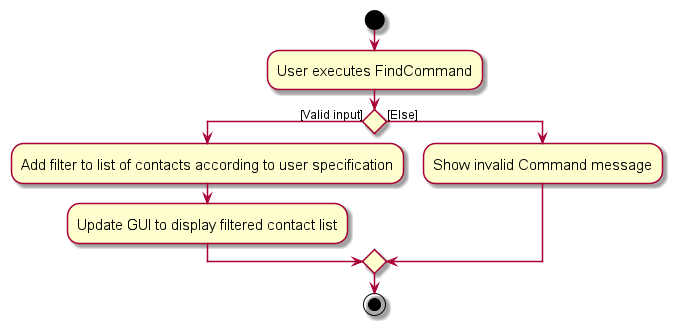
Design considerations
The feature is implemented this way so that the user is able to access a particular student’s contact quickly and conveniently without having to scroll through the entire course list. By allowing the user to search by prefixes or student IDs, there is a lot more freedom in terms of how the user wants to access the student’s contact.
Alternative implementations considered but not adopted:
-
Only allowing the user to find contacts by name
Instead of having the user to enter the prefix everytime they want to find a contact, the process can be sped up by narrowing the functionality of this command to only find by name.
Pros:
- Implementation would be quite straightforward and simple as the default
findfeature would suffice for the feature specifications. - The user need not enter the prefix everytime they want to use
find, reducing the time taken to search for contacts.
Cons:
- The freedom of the user is limited greatly, considering that finding by student ID in a university is also rather common. By constraining them to a single search method, the user may end up spending more time finding students with longer names.
Evaluation:
The current implementation is the optimal way to go about implementing this feature as we believe that the value added by the feature triumphs the effort needed for implementation.
- Implementation would be quite straightforward and simple as the default
Merging two students merge
Implementation
This merge feature allows the user to merge two students. The merged student will possess the NAME, EMAIL, PHONE NUMBER, and TUTORIAL GROUP ID of the primary student. The merged student will also have the tags of both students, and their merged attendance records.
The following sequence diagram shows how the MergeCommand function works:
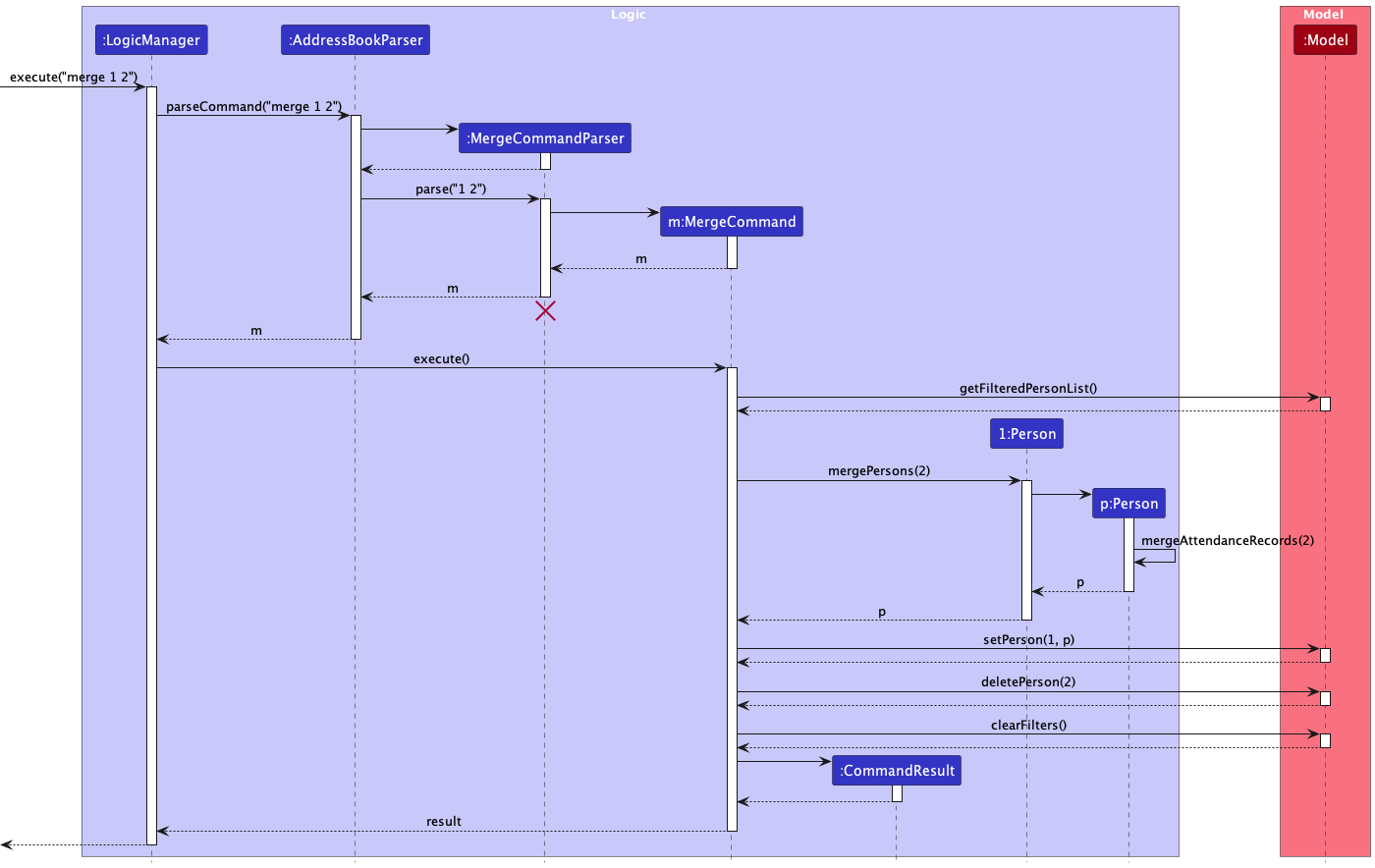
In this example, the user enters merge 1 2.
MergeCommandParser should end at the destroy marker (X) but due to a limitation of PlantUML, the lifeline reaches the end of diagram.
The following activity diagram summarizes what happens when a user executes a MergeCommand:

Design considerations
The feature is implemented this way so that the user is able to quickly merge any duplicated students, without having to manually edit the student and add the tags and attendance records from one student to another.
Alternative implementations considered but not adopted:
-
Editing the primary student instead of creating a new student.
Pros:
- Greater efficiency since there is less overhead in creating a new Person.
Cons:
- This implementation would mean that we have to increase the mutability of the Person class, which is undesirable.
Evaluation:
The current implementation is the optimal way to go about implementing this feature as we believe that there is greater value in preserving the immutability of the Person class.
Delete features
Two types of delete commands, delete INDEX and delete all, have been implemented.
delete INDEX allows users delete a singular student via their index in the list.
delete all allows users to delete multiple students at once.
Implementation
Both delete commands are parsed with DeleteCommandParser. If parsed successfully, it returns a DeleteCommand object.
The following sequence diagram shows how DeleteCommand works:

In this example, the user enters delete all tg/G1, where there are valid students in Tutorial Group G1.
DeleteCommandParser should end at the destroy marker (X) but due to a limitation of PlantUML, the lifeline reaches the end of diagram.
Design considerations:
DeleteCommand is implemented to give users greater flexibility, as it allows them to delete a student by index, delete multiple students in the course by tutorial group or delete all students in the course.
The ability to delete multiple students was chosen as it provides greater efficiency as compared to deleting students one by one.
Alternative implementations considered but not adopted:
-
Different format for information shown by
DeleteCommandInstead of the UI message showing a success message followed by listing (all) the student(s) deleted, we could have it show a success message only.
Pros:
- Reduces clutter in the UI message.
Cons:
- Users would not know which students were deleted, especially when utilising
delete allordelete all tg/xxon a large tutorial group. - Once the student is deleted, the user loses their information completely and would not be able to add them back easily.
Evaluation:
The current implementation is preferred as it is more user-friendly, and provides the user with valuable information. Listing the information of students deleted allows the user to be able to check if they deleted the correct students. If a student was deleted by mistake, the user can easily reference the UI message containing the student’s information to add them back, ensuring a more reliable and user-friendly experience.
Separate Address Book for each Course
Implementation
In the ModelManager class, instead of storing an AddressBook, we store a AddressBookManager.
The AddressBookManager has a few responsibilities:
- Adding or deleting
AddressBook - Setting the active
AddressBook - Getting the active
AddressBook
Existing methods such as saveAddressBook in AddressBookStorage have been modified to store an AddressBookManager instead. The serialization and deserialization of AddressBookManager is also now handled by the nested AddressBookManagerSerializer class as well as AddressBookManagerDeserializer class within AddressBookManager. A CourseCommand is also added to facilitate the user switching address book, creating, deleting and editing them.
Course commands are parsed with CourseCommandParser. If parsed successfully, it returns a CourseCommand.
The following sequence diagram shows how CourseCommand works:
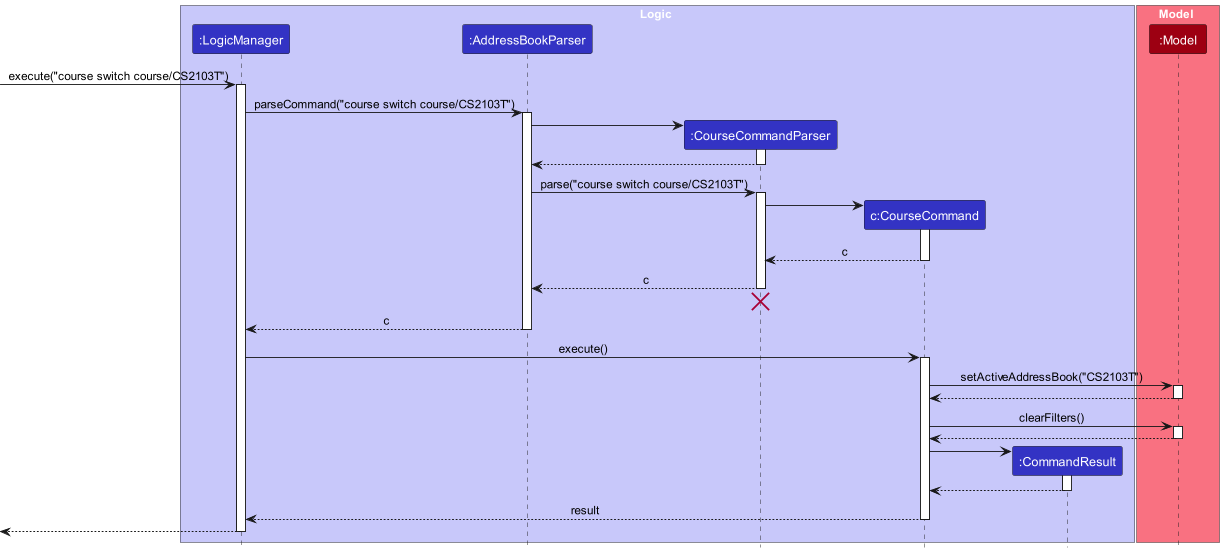
In this example, the user enters course switch course/CS2103T, to switch to another valid address book with course code “CS2103T”.
CourseCommandParser should end at the destroy marker (X) but due to a limitation of PlantUML, the lifeline reaches the end of diagram.
Design considerations:
The getAddressBook method in ModelManager is now a wrapper for the getActiveAddressBook method in
AddressBookManager. This ensures that any existing commands will still “see” the model as having one AddressBook,
and not break any existing functionality.
Alternative implementations considered but not adopted:
-
Updating the structure in
ModelManagerInstead of having a new class
AddressBookManager, we simply update the existing structure to use aHashMap<String, AddressBook>.Pros:
- Easier to understand: Developers who are new to the codebase do not need to learn and understand the
AddressBookManagerclass and its interactions, which could potentially increase the learning curve for the codebase.
Cons:
- Harder to maintain: In the future, should any changes be needed for address book management, there may need to refactor a significant portion of the codebase, as the logic is distributed. This can be error-prone and time-consuming.
- Harder to Store: Without a dedicated AddressBookManager class, there is a need to refactor a significant portion of the existing storage mechanism to take in a HashMap of
AddressBook.
Evaluation: The proposed implementation is preferred as even though it introduces additional complexity, it allows for better maintainability of the codebase as the responsibility of handling
AddressBookis now handled by theAddressBookManagerclass. The ease of extensibility outweighs the complexity introduced. - Easier to understand: Developers who are new to the codebase do not need to learn and understand the
[Proposed] Undo/redo feature
Proposed Implementation
The proposed undo/redo mechanism is facilitated by VersionedAddressBook. It extends AddressBook with an undo/redo history, stored internally as an addressBookStateList and currentStatePointer. Additionally, it implements the following operations:
-
VersionedAddressBook#commit()— Saves the current address book state in its history. -
VersionedAddressBook#undo()— Restores the previous address book state from its history. -
VersionedAddressBook#redo()— Restores a previously undone address book state from its history.
These operations are exposed in the Model interface as Model#commitAddressBook(), Model#undoAddressBook() and Model#redoAddressBook() respectively.
Given below is an example usage scenario and how the undo/redo mechanism behaves at each step.
Step 1. The user launches the application for the first time. The VersionedAddressBook will be initialized with the initial address book state, and the currentStatePointer pointing to that single address book state.

Step 2. The user executes delete 5 command to delete the 5th person in the address book. The delete command calls Model#commitAddressBook(), causing the modified state of the address book after the delete 5 command executes to be saved in the addressBookStateList, and the currentStatePointer is shifted to the newly inserted address book state.

Step 3. The user executes add n/David … to add a new person. The add command also calls Model#commitAddressBook(), causing another modified address book state to be saved into the addressBookStateList.

Model#commitAddressBook(), so the address book state will not be saved into the addressBookStateList.
Step 4. The user now decides that adding the person was a mistake, and decides to undo that action by executing the undo command. The undo command will call Model#undoAddressBook(), which will shift the currentStatePointer once to the left, pointing it to the previous address book state, and restores the address book to that state.

currentStatePointer is at index 0, pointing to the initial AddressBook state, then there are no previous AddressBook states to restore. The undo command uses Model#canUndoAddressBook() to check if this is the case. If so, it will return an error to the user rather
than attempting to perform the undo.
The following sequence diagram shows how the undo operation works:

UndoCommand should end at the destroy marker (X) but due to a limitation of PlantUML, the lifeline reaches the end of diagram.
The redo command does the opposite — it calls Model#redoAddressBook(), which shifts the currentStatePointer once to the right, pointing to the previously undone state, and restores the address book to that state.
currentStatePointer is at index addressBookStateList.size() - 1, pointing to the latest address book state, then there are no undone AddressBook states to restore. The redo command uses Model#canRedoAddressBook() to check if this is the case. If so, it will return an error to the user rather than attempting to perform the redo.
Step 5. The user then decides to execute the command list. Commands that do not modify the address book, such as list, will usually not call Model#commitAddressBook(), Model#undoAddressBook() or Model#redoAddressBook(). Thus, the addressBookStateList remains unchanged.

Step 6. The user executes clear, which calls Model#commitAddressBook(). Since the currentStatePointer is not pointing at the end of the addressBookStateList, all address book states after the currentStatePointer will be purged. Reason: It no longer makes sense to redo the add n/David … command. This is the behavior that most modern desktop applications follow.

The following activity diagram summarizes what happens when a user executes a new command:

Design considerations:
Aspect: How undo & redo executes:
-
Alternative 1 (current choice): Saves the entire address book.
- Pros: Easy to implement.
- Cons: May have performance issues in terms of memory usage.
-
Alternative 2: Individual command knows how to undo/redo by
itself.
- Pros: Will use less memory (e.g. for
delete, just save the person being deleted). - Cons: We must ensure that the implementation of each individual command are correct.
- Pros: Will use less memory (e.g. for
Documentation, logging, testing, configuration, dev-ops
Appendix: Requirements
Product scope
Target user profile:
- is a Teaching Assistant (TA) for National University of Singapore Computer Science courses
- has a need to manage a significant number of student information
- prefer desktop apps over other types
- can type fast
- prefers typing to mouse interactions
- is reasonably comfortable using CLI apps
Value proposition: provide a convenient one-stop platform for tutors to keep track of the contact details and attendance records of each student
User stories
Priorities: High (must have) - * * *, Medium (nice to have) - * *, Low (unlikely to have) - *
| Priority | As a … | I want to … | So that I can… |
|---|---|---|---|
* * * |
meticulous user | mark attendance for each student separately | make sure each students’ attendance record is accurate |
* * * |
user | see a summary of attendance records | verify the attendance records |
* * * |
user | easily create new or edit contacts | easily add or remove contacts |
* * * |
user | search for a student by name or student ID | quickly access their attendance and contact details |
* * * |
user | view a list of all my students | quickly scan who’s in my tutorial groups |
* * * |
user | filter for specific tutorial groups | efficiently engage in tutorial-group-based tasks such as marking attendance after a lesson |
* * |
frequent user | organise my students’ contacts by modules | better manage my students |
* * |
forgetful user | add additional notes for my students | better remember my students |
* * |
user | indicate reason for absence | know when there is a valid excuse |
* * |
user | be able to search for contacts using keywords (modules) | more easily find contacts |
* * |
user | categorize students into different tutorial groups | manage and monitor each group efficiently |
* * |
user | view the tallied attendance over the semester of each student | submit their overall attendance mark quickly |
* * |
user | remove students from the address book | avoid having unnecessary contacts |
* * |
impatient user | mass mark attendance for all my students | mark attendance more efficiently |
* * |
long-term user | delete all contacts from tutorial group at once | avoid doing so one-by-one after the module ends |
* * |
long-term user | archive past module records | have a less cluttered workspace |
* * |
new user | have the application feel intuitive | easily learn the various functions |
* * |
careless user | undo my last action | recover any important data |
* |
new user | import my contacts from another database | easily get started using the app |
* |
user | export my attendance records to another database | easily upload attendance records |
* |
forgetful user | be reminded on incomplete attendance records | rectify any potential gaps in the records |
* |
user | add pictures to the contacts | easily identify my students |
* |
forgetful user | merge duplicate contacts | avoid having duplicate contacts jamming up the application |
* |
busy user | set reminders if I have a meeting with the student | remember all one-on-one meetings that I have with the students |
* |
user | view a count of how many sessions each student has missed | identify frequent absentees |
* |
user | add simple notes next to a student’s name (like “late submission”) | remember specific incidents |
* |
user | add and edit status of work submissions | keep track of the students’ work |
* |
user | track the submission status of each student’s assignments | be aware of who has or hasn’t turned in their work |
* |
user | add and view my student’s preferred name | call on them with the correct name |
Use cases
(For all use cases below, the System is TAvigator and the Actor is the user, unless specified otherwise)
Use case: UC01 - Creating and editing a new address book
MSS
-
User creates a new address book with a valid course code.
Use case ends.
Extensions
-
1a. User edits the course code. Use case ends.
-
1b. User enters an invalid course code.
-
1b1. TAvigator prompts the user to enter a valid course code.
Use case ends.
-
Use case: UC02 - Switching to a different address book
MSS
-
User switches to a different address book.
Use case ends.
Extensions
- 1a. The address book that the user is trying to switch to does not exist.
-
1a1. TAvigator prompts the user to switch to a valid address book.
Use case ends.
-
Use case: UC03 - Creating a new contact and editing relevant information
Precondition: User is on a course address book.
MSS
-
User creates a new contact.
Use case ends.
Extensions
-
1a. User edits the contact details.
Use case ends.
-
1b. User finds a duplicated contact.
-
1b1. User merges the duplicated contacts.
Use case ends.
-
Use case: UC04 - View Summary of Attendance Records
Precondition: User is on a course address book.
MSS
- User requests to view a summary of attendance records and enters a week and a tutorial group ID.
-
TAvigator shows a summary of attendance records for the corresponding week and tutorial group.
Use case ends.
Extensions
- 1a. User leaves the tutorial group ID blank.
-
1a1. TAvigator shows a summary of attendance records of all students in the course for the week specified.
Use case ends.
-
- 1b. User leaves the week blank.
-
1b1. TAvigator shows an error message.
Use case ends.
-
- 1c. User enters an invalid tutorial group ID.
-
1c1. TAvigator shows an error message.
Use case ends.
-
- 1d. User enters a tutorial group with no students in it.
-
1d1. TAvigator shows a reminder that no students are in the tutorial group and shows no students.
Use case ends.
-
Use case: UC05 - View List of Students
Precondition: User is on a course address book.
MSS
- User requests to view a list of students.
-
TAvigator shows a list of all students in the course.
Use case ends.
Use case: UC06 - Mark Student Attendance Separately
Precondition: User is on a course address book.
MSS
- User requests to mark attendance for a student and enters student name or ID, followed by the attendance status and week and reason if any.
-
TAvigator marks the attendance of student and displays message for confirmation of attendance.
Use case ends.
Extensions
- 1a. The given student name or ID is invalid.
-
1a1. TAvigator shows an error message.
Use case ends.
-
- 1b. The given attendance record is invalid.
-
1b1. TAvigator shows an error message.
Use case ends.
-
- 1c. The given week is invalid.
-
1c1. TAvigator shows an error message.
Use case ends.
-
- 1d. The no reason provided for absence.
-
1d1. TAvigator shows an error message.
Use case ends.
-
Use case: UC07 - Search For Contacts via Student Name or ID
Precondition: User is on a course address book.
MSS
- User requests to search for a contact via student name or ID.
- User enters desired student name or ID.
-
TAvigator shows list of students with matching name or ID.
Use case ends.
Extensions
- 3a. The given ID or name does not exist.
-
3a1. TAvigator shows message indicating that contacts with the specified names or ID do not exist.
Use case ends.
-
- 3b. User leaves the student name or ID blank
-
3b1. TAvigator shows an error message.
Use case ends.
-
- 3c. User enters an invalid student name or ID
-
3c1. TAvigator shows an error message.
Use case ends.
-
Use case: UC08 - Delete a Student
Precondition: User is on a course address book.
MSS
- User requests to list students.
- TAvigator shows a list of students.
- User requests to delete a specific student in the list by entering the index corresponding to their position in the list.
-
TAvigator deletes the student.
Use case ends.
Extensions
-
2a. The list is empty.
Use case ends.
-
3b. User enters an invalid index.
-
3b1. TAvigator shows an error message.
Use case resumes at step 2.
-
Use case: UC09 - Delete Multiple Students
Precondition: User is on a course address book.
MSS
- User requests to delete students and enters a tutorial group to delete.
-
TAvigator deletes all students from the tutorial group in the course.
Use case ends.
Extensions
- 1a. User leaves the tutorial group blank.
-
1a1. TAvigator deletes all students in the course.
Use case ends.
-
- 1b. User enters an invalid tutorial group ID.
-
1b1. TAvigator shows an error message.
Use case ends.
-
- 1c. User enters a tutorial group with no students in it.
-
1b1. TAvigator shows a reminder that no students are in the tutorial group and shows a list of all students in the course.
Use case ends.
-
Non-Functional Requirements
- Should work on any mainstream OS as long as it has Java
11or above installed. - Should be able to hold up to 1000 persons without a noticeable sluggishness in performance for typical usage.
- A user with above average typing speed for regular English text (i.e. not code, not system admin commands) should be able to accomplish most of the tasks faster using commands than using the mouse.
- Should retain a majority of the core functionality even without internet access
- Application should not exceed file size of 50MB
- Should respond to user inputs within approximately 2 seconds
- Should show understandable messages to users and not crash under recoverable errors
- Application should have an intuitive and user-friendly interface, following design principles
- Should provide clear and comprehensive user documentation to assist users in using the application effectively
- Should maintain technical documentation for developers, detailing the software architecture
Glossary
- Mainstream OS: Windows, Linux, Unix, OS-X
- Private contact detail: A contact detail that is not meant to be shared with others
Appendix: Instructions for manual testing
Given below are instructions to test the app manually.
Launch and shutdown
-
Initial launch
-
Download the jar file and copy into an empty folder
-
Open a terminal tab and navigate to the same folder that contains the jar file
-
Run the jar file with the command
java -jar tavigator.jar
Expected: Shows the GUI with a set of sample courses and students. The window size may not be optimum.
-
-
Saving window preferences
-
Resize the window to an optimum size. Move the window to a different location. Close the window.
-
Re-launch the app.
Expected: The most recent window size and location is retained.
-
-
Exiting the app
- The application can be exited with the
exitcommand, or simply clicking the exit button of the tab.
- The application can be exited with the
Creating, editing and deleting a course.
-
Test case:
course create course/CS2040S
Expected: A new course with the name “CS2040S” is created, and appears in the navigation bar. -
Test case:
course edit course/CS2040
Expected: The currently active course should be renamed to “CS2040”. -
Test case:
course delete course/CS2040
Expected: The course with name “CS2040” should be deleted. If CS2040 is the currently active course, the GUI should update to display another present course.
Adding and editing a student.
-
Test case:
add n/Fu Yiqiao p/91234567 e/fyq@gmail.com id/A1234569E t/G2Expected: A new student is created under the currently active course, and added to the end of the list. (Provided there is no other student with the same ID) -
Test case:
add n/9 p/91234567 e/fyq@gmail.com id/A1234569A t/G2Expected: No new student added, error message displayed (Names should only contain alphabetical characters and spaces, and it should not be blank) -
Test case:
add n/Fu Yiqiao p/91234567 e/fyq@gmail.com id/1234569E t/G2Expected: No new student added, error message displayed (Please enter the full ID! IDs should only contain alphanumeric characters, with no special characters or space, and it should not be blank) -
Test case:
edit 1 n/Tan LiyanExpected: The name of the first person should be edited to be Tan Liyan. -
Test case:
edit 1 n/9Expected: No edit made, error message displayed (Names should only contain alphabetical characters and spaces, and it should not be blank)
Deleting a person
-
Deleting a person while all persons are being shown
-
Prerequisites: List all persons using the
listcommand. Multiple persons in the list. -
Test case:
delete 1
Expected: First contact is deleted from the list. Details of the deleted contact shown in the status message. Timestamp in the status bar is updated. -
Test case:
delete 0
Expected: No person is deleted. Error details shown in the status message. Status bar remains the same. -
Test case:
delete all tg/G2
Expected: All students from tutorial group G02 in the currently selected course are deleted. -
Test case:
delete all
Expected: All students in the currently selected course are deleted. -
Other incorrect delete commands to try:
delete,delete x,...(where x is larger than the list size)
Expected: Similar to previous.
-
Marking and Viewing Attendance
-
Test case:
mark n/Zong Jin, Fu Yiqiao a/1 w/1Expected: Marks students named, Zong Jin and Fu Yiqiao, as present for the tutorial in Week 1. Tallied attendance display should update accordingly. -
Test case:
mark n/Zong Jin a/0 w/2 r/not feeling wellExpected: Marks student named Zong Jin as not present for the tutorial in Week 2. Tallied attendance display should update accordingly. -
Test case:
mark n/Zong Jin a/0 w/2Expected: No attendance marked. Error message displayed. -
Test case:
mark n/Zong Jin a/1 w/2Expected: Attendance of Zong Jin in week 2 should be updated to present. Tallied attendance display should update accordingly. -
Test case:
mark n/Zong Jin a/2 w/2Expected: No attendance marked. Error message displayed (Attendance should only be 0 or 1, where 0 indicates student is absent and 1 indicates student is present). -
Test case:
mark n/Zong Jin a/2 w/15Expected: No attendance marked. Error message displayed (Week should be an integer from 0 to 13). -
Test case:
view 1Expected: Displays the detailed attendance records for the first student in the currently displayed list. -
Test case:
mark n/Zong Jin, Fu Yiqiao id/A0123456E, A0123457E a/1 w/1Expected: No attendance marked. Error message displayed.
Saving data
-
Dealing with missing/corrupted data files
- Ensure that the data/tavigator.json file is present in the same directory where the jar file is located. Else, launch the application and exit.
- To simulate missing data files, delete the json file.
Expected behaviour: TAvigator starts with preloaded courses and students.
- To simulate a corrupted data file, use a text editor to edit the json file.
Expected behaviour: TAvigator should fail to launch.
Appendix: Planned Enhancements
Given below are some of the possible enhancements that could be added in future iterations:
- More flexibility in student names.
Currently, student names cannot contain any special characters like
,or-that might exist in some names. We plan to allow specific special characters for student names in future developments. - More detailed error messages for mark command.
The current error message for a failed
markcommand may be too general. We plan to add details to the error message that explains the reason of failure especially when reason of absence is not provided for students who are marked as absent:Reason of absence (r/) is mandatory for students who are marked as absent. - Stricter validation checks for course codes.
Validation checks could be added for course names to ensure valid course names when adding or editing courses. A valid format would include two to three initial alphabetical letters, followed by four numbers and one optional alphabetical letter at the end. A valid example would be
CS2103T. An alternative could be getting a list of course codes from the NUSMods API but that may require constant updating. - Importing records.
We plan to implement importing student records from a csv file in the future, which may create duplicated records. This would be where our merge command comes into play, merging duplicated records so that no information is lost.
- More functionality for
markcommand.Currently
markcommand’s design does not encompass a few nice-to-haves. We plan to add support for the following:- Marking of students with the same student name.
- Marking of students with both student name field and student ID field.
- Marking of students with case-insensitive student name.
- Marking of students using the index in list.
- Marking attendance based on tutorial group instead of student.
Currently, TAvigator supports a student having multiple tutorial groups, but attendance is marked based on the student only. As such, we plan to modify the
markcommand so that it takes in atg/input, and attendance can be marked separately for each tutorial group the student belongs to. - Better parsing of invalid arguments.
Currently, adding invalid and redundant prefixes after commands will cause TAvigator to take the invalid prefix and its value as part of the value of the closest valid prefix.
For example,add n/Fu Yiqiao p/98765432 e/fyq@example.com id/ A1234567M t/G2 r/returns an error message that: Tutorial Group IDs should be alphanumeric. The correct error message that should be shown is: Invalid prefix r/ detected. - Improved parsing of duplicated predicates.
Some commands in our app allows for duplicate inputs, such w/1 w/2 w/3, and takes the last one as the input to be parsed. In the future, we plan to disallow this type of inputs.
- Improved UI for attendance records
Currently, it displays the attendance records in multiple lines and require scrolling, which makes it hard to view all information at a glance. We plan to improve the UI by either showing the attendance records using boxes instead, with colours differentiating the different status for their attendance, such as using green for present, red for absent and grey for unmarked.
- Standardise prefix for tutorial group
Currently,
addandeditcommand usest/prefix whilelist attendanceanddelete alluses thetg/prefix. We plan to standardise the prefix to use thetg/prefix to avoid confusion.
Appendix: Effort
Effort required
Adding support for multiple address books
One of the major changes of TAvigator was the implementation of multiple address books, instead of AB3’s singular address book.
Details of implementation can be found here.
This required significant code restructuring, as well as new classes such as the AddressBookManager added in order to support this feature
(PR).
The UI also had to be updated accordingly to allows the user to easily switch between different address books.
More Viewing Options
TAvigator has also added support for more viewing options of the list of students. This is implemented in the form of more serializable predicates, which are used to check for conditions such as: whether a student is absent from tutorial, whether a student is present in a tutorial group, whether a name contains a keyword, and whether an ID contains a keyword. These predicates allow the user to view students not only by name, but also by ID, tutorial group, and attendance records. We went a step further to save the last viewing option in the preferences.json file, so that the user will be able to quickly refer back to their last viewed option on startup.
Challenges faced
During the initial phase, it took us considerable amount of time to familiarise ourselves with the code base, and learn our ways around the layers of abstractions, as well as how the different components interacted with each other. As we progressed and moved on to more complex implementations, we realised that sometimes our planned features were interdependent, meaning that we were left with tight and consecutive windows to implement our individual features.
Most importantly, we slowly learnt to communicate better through the process. This really helped to move our project forward as we were more comfortable sharing our opinions on each other thoughts, boosting our efficiency as a whole.
Achievements
Despite all the challenges faced and all the time and effort it took to polish our project, we are proud to present TAvigator. We hope that TAvigator will become a one stop solution that will benefit all SOC TAs.